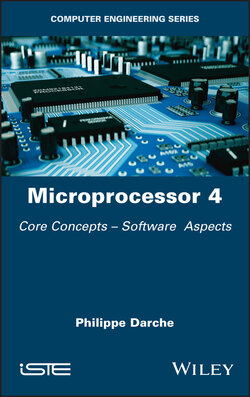Читать книгу Microprocessor 4 - Philippe Darche - Страница 22
1.2.3.1. Direct addressing
ОглавлениеDirect or absolute addressing is without doubt the most natural. It can access a memory address location A defined (i.e. arranged immediately) after the instruction code in the operand field (Figure 1.10). It can therefore be considered a constant. The effective address EA is given by the following formula:
[1.1]
Figure 1.10. Instruction with direct addressing
It can be used by jump instruction to branch to a set location in the program. This mode is in fact an indirect mode with auto-incrementation using the PC (Program Counter) as an indirection register (cf. § 1.2.3.3 for indirection).
This mode allows for variations depending on the format of the address provided, the benefit lies in reducing the instruction's memory size. Some manufacturers thus distinguish the short mode from the extended mode, known as long mode, depending on the format of the address A, provided. In the short mode (absolute short, page zero, also known direct at Motorola, a base page (IEEE 1985)) illustrated in Figure 1.11, the address is expressed in a smaller format than that of a microprocessor. The address field may also be smaller than 3 bits, one example being the 8021 microcontroller from Intel or, classically, 8 bits in 8-bit MPUs. Page zero can be seen as a bank of registers (RF for Register File, cf. § V3-3.1.11.1). The MIPS firm speaks of pseudo-direct addressing. Aside from a smaller format, the second benefit lies in decreasing the number of memory accesses to fetch the instruction code and the operand address. It is equivalent to a basic addressing + displacement, as in the IBM System/370 architecture, with a null base address. One example is the MC6802 microprocessor where the address is in byte format, while the format of the MPU address bus is double. This then limits the address space to the interval [00, FF]16, hence the term “absolute short addressing” or “page zero”6 (if the size of the memory page is 256 bytes). In the example below, the A register receives the content of memory location 00.
Figure 1.11. Instruction with an address at page 0
The concept of page zero addressing has been improved with direct page addressing. The direct page is now movable in a larger memory page. The start of the page is addressed by a specialized register (cf. § V3-3.1.1). We cite MC6809 (a page of 256 bytes in a space of 64 KiB, addressing capacity of the MPU itself, direct page (DP) register), the 65CE02 from Commodore Semiconductor Group or CSG (the same as before except that its addressing capacity is higher, base page register B) and the 65816 from the firm Western Digital Corporation (WDC) with an address over 16 bits in the direct page register D.
A direct addressing is limited in its extent for a given instruction format; there are bits reserved for coding the instruction, which should be subtracted from the bits reserved for the addressing. This limitation can be lifted if the instruction format is not limited (i.e. variable format). With extended addressing, the address belongs to the microprocessor's address space without restriction. The format is that of the address bus. It should be noted that the absolute address can be implemented with a basic address + displacement with a basic register with zero content base.
